Archaeological Site of Olympia: Olympia is situated on the Peloponnese in Greece. Ancient Olympia became a sanctuary for the worship of Zeus in the 10th century BC. There are several ancient sanctuaries in Greece, the most famous are in Athens, Delphi, Olympia, Epidaurus and on the island of Delos. Olympia is the birthplace of the Olympic Games. The Ancient Olympic Games were held every four years in honour of the Greek god Zeus, beginning in 776 BC. The Ancient Olympic Games continued uninterruptedly for nearly twelve centuries until Emperor Theodosius I banned the 'pagan cults' in 394 AD. The first Modern Olympic Games were held in Athens in 1896. The Archaeological Site of Olympia has one of the highest concentrations of masterpieces of the Ancient Greek World. The site holds the remains of a number of temples and sports structures erected for the Ancient Olympic Games. The tradition of lighting the Olympic flame originated in the Netherlands during the Modern Olympic Games in 1928. Every four years, the Olympic flame for the Modern Olympic Games begins its journey from Ancient Olympia. The Archaeological Museum of Olympia exhibits artifacts found in the Archaeological Site of Olympia. The museum is one of the most important archaeological museums in Greece, it is located on the Archaeological Site of Olympia. Olympia is located about 50 km from another UNESCO World Heritage Site, the Temple of Apollo Epicurius at Bassae. The Archaeological Site of Olympia became a UNESCO World Heritage in 1989.
www.werelderfgoedfotos.nl © Copyright World Heritage Photos
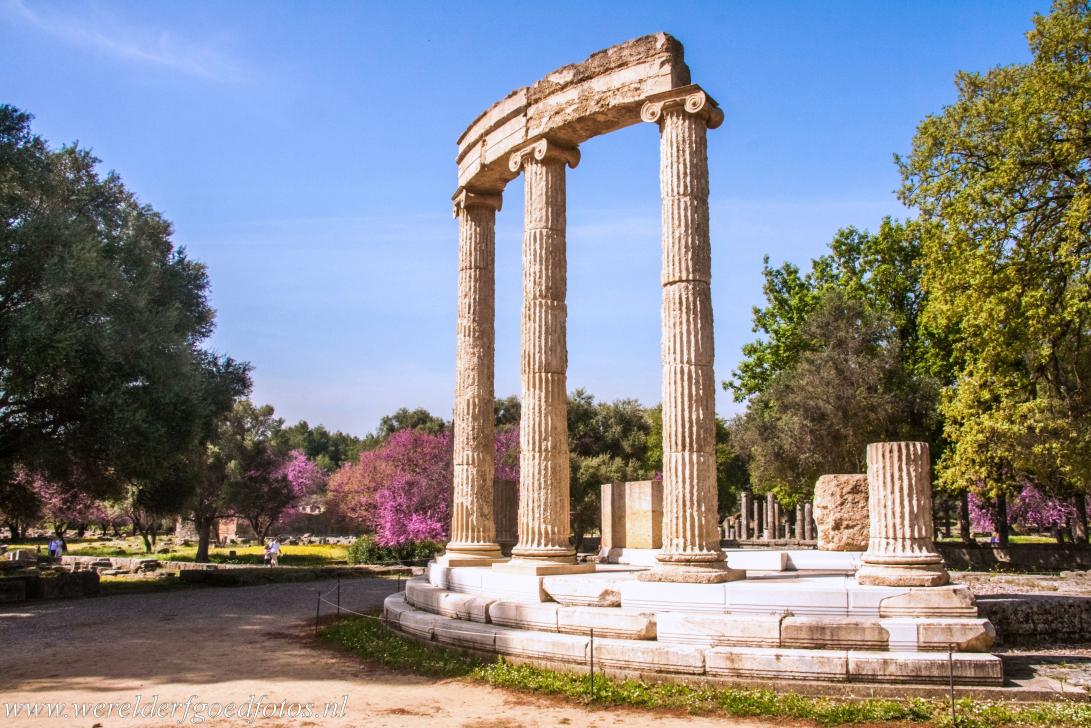
Archaeological Site of Olympia: The Philippeion was a circular building, a tholos in the Ionic style. King Philip II of Macedon commissioned the construction of the Philippeion around 338 BC, the construction of the tholos was completed during the reign of his son King Alexander the Great. The Archaeological Site of Olympia is renowned for its high concentrations of the Ancient Greek masterpieces. Olympia is one of the most important Ancient Greek sanctuaries. Archaeological Olympia was declared a UNESCO World Heritage Site in 1989.

Archaeological Site of Olympia: The Philippeion was a circular building, a tholos in the Ionic style. King Philip II of Macedon commissioned the construction of the Philippeion around 338 BC, the construction of the tholos was completed during the reign of his son King Alexander the Great. The Archaeological Site of Olympia is renowned for its high concentrations of the Ancient Greek masterpieces. Olympia is one of the most important Ancient Greek sanctuaries. Archaeological Olympia was declared a UNESCO World Heritage Site in 1989.
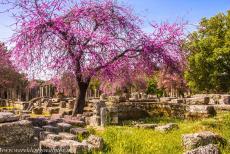
Archaeological Site of Olympia: A pink flowering Judas tree in the Palaestra of Ancient Olympia. The Palaestra was the wrestling school where competitors were required to train. Olympia was a sanctuary with a collection of buildings, temples, houses for the priests, guest houses, baths, areas for the athletes, treasuries and auxiliary buildings. The sanctuary, known as the Atlis, the sacred grove of Zeus, was dedicated to Zeus, the Greek supreme god, who ruled as the king of the gods from Mount Olympus.
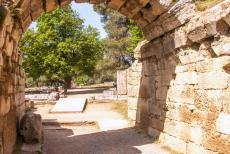
Archaeological Site of Olympia: The Krypte is the official entrance gate to the stadium of Ancient Olympia. The vaulted gate was 32 metres long. The gate was built in the late 3th century BC. The Krypte was only used by the Olympic officials, the athletes, the priests and other dignitaries. The ancient stadium of Olympia was the first stadium ever built. Ancient Olympia is the birthplace of the Olympic Games, the games were held every four years in honour of the Ancient Greek god Zeus, beginning in 776 BC.
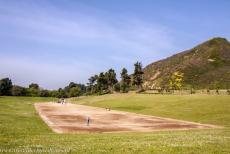
Archaeological Site of Olympia: The Olympia Stadium dates from the 5th century BC. This is the site of the Ancient Olympic Games. The start and finish of the stadium track were marked with a row of marble slabs. The stadium track was made of compacted clay. The distance between the starting line and finishing line was 600 Olympic feet, 192.28 metres. The Olympia Stadium was surrounded by gently sloping hills on all four sides, the grassy slopes could accommodate about 45,000 spectators.
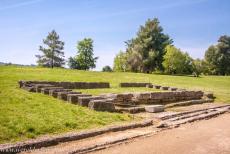
Archaeological Site of Olympia: The Exedra was a stone platform in the Olympia Stadium, it served as a seating for spectators. The Exedra was reserved for the Olympic officials, priests and other dignitaries, the other spectators sat on the ground. The Ancient Stadium of Olympia is the oldest stadium in the world. The first Olympic Games were held in honour of Zeus in 776 BC. In 394 AD, the Ancient Olympic Games were banned by the Roman Emperor Theodosius I. The first Modern Olympic Games were held in Athens in 1896.
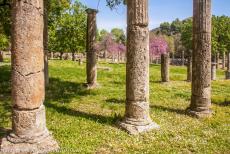
Archaeological Site of Olympia: The Doric columns of the Palaestra, the wrestling school in Ancient Olympia. The Palaestra was a square building, the inner courtyard was surrounded by a colonnade, the Doric colonnade consisted of 72 columns that supported a roof, it created shade and shelter for athletes. The Palaestra was built in the 3th century BC as part of the gymnasium complex. Each side of the Palaestra was approx. 66 metres long. Today, the ancient building is in ruins and many columns are totally destroyed.
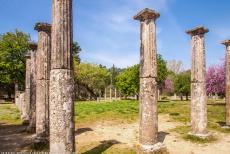
Archaeological Site of Olympia: The Doric columns of the Palaestra or the wrestling school. The Archaeological Site of Olympia consists of the remains of several temples and sports structures built for the Ancient Olympic Games. Ancient Olympia was partly destroyed in the 3th century. In the 6th century, a powerful earthquake destroyed the buildings, Nowadays, only the ancient ruins of the buildings remain. The Archaeological Site of Olympia gained the status as a UNESCO World Heritage in 1989.
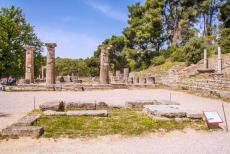
Archaeological Site of Olympia: The Temple of Hera and the altar where the Olympic flame is lit by the sun. The temple was erected around 590 BC. It was one of the earliest Doric temples in Greece. The temple was dedicated to Hera, the queen of the Greek gods. In the 4th century, the temple was destroyed by an earthquake. The Dutch architect Jan Wils introduced the tradition of the Olympic flame. In 1928, the Olympic flame was lit for the first time at the Olympic Games in the Netherlands.
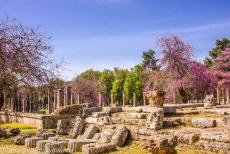
Archaeological Site of Olympia: The ruins of Ancient Olympia. The Roman Conquest of Greece in 146 BC did not affect the Olympic Games. Roman Emperors were supporters of the sanctuary and the Olympic Games. Several buildings were erected, such as baths and hostels. The Ancient Olympic Games were held for the last time in 393 AD. In the 6th century, Ancient Olympia was destroyed by a series of powerful earthquakes and a tsunami. Around 425 AD, a small Christian community settled in the temple ruins.
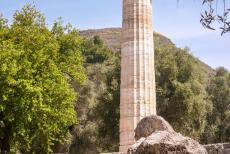
Archaeological Site of Olympia: The remains of the Temple of Zeus, the most important building at Olympia. Ancient Olympia was dedicated to Zeus, the king of the gods of the Ancient Greeks. The first Ancient Olympic Games in 776 BC were dedicated to Zeus. The Ancient Olympic Games continued uninterruptedly for almost twelve centuries until the Roman Emperor Theodosius I, also known as Theodosius the Great banned, the 'pagan cults' in 394. in that time, Greece was ruled by the Roman Empire.
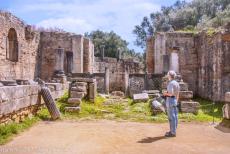
Archaeological Site of Olympia: The ruins of the workshop of the sculptor Phidias, also known as Feidias. In his workshop, Phidias created the statue of Zeus, which is considered to be one of the Seven Wonders of the Ancient World, it was made of ivory and gold and depicted Zeus seated on a throne. Unfortunately, the enormous statue of Zeus no longer exists. Between 435 AD and 451 AD, an Early Christian basilica was erected over the ruined foundations of the workshop of Phidias. The basilica was destroyed by an earthquake in 551 AD.
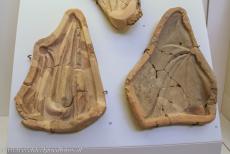
Archaeological Museum of Olympia: These clay moulds were used to shape the gold plates for the statue of Zeus, they were found in the workshop of the sculptor Phidias. The workshop was excavated in the 1950s, archaeologists discovered sculptor's tools, modelling plaster, these clay moulds and a pit for casting bronze. The moulds are exhibited in the Archaeological Museum of Olympia, an important museum in Greece, situated next to the Archaeological Site of Olympia. The Archaeological Site of Olympia is situated in the Ilia (Elis) region on the Peloponnese.
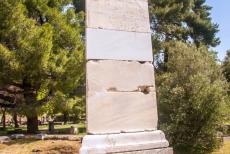
Archaeological Site of Olympia: The statue of Nike of Paionios once stood on this obelisk, the statue depicts a winged woman. The triangular-shaped obelisk was 8.81 metres high. Together, the obelisk and the statue were nearly eleven metres high. The statue of Nike was created by Paionios of Mende, one of the greatest sculptors of Ancient Greece. The statue was erected to commemorate a victory by Athens over Sparta during the Peloponnesian War. Nowadays, the statue is exhibited in the Archaeological Museum of Olympia.
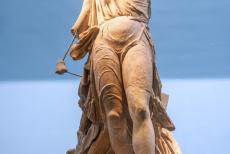
The statue of Nike of Paionios, the Greek goddess of victory, is exhibited in the Archaeological Museum of Olympia, the statue was made from Parian marble. The statue is 2.12 metres high. It was made by the sculptor Paionios of Mende between 425 BC and 421 BC. The Archaeological Museum of Olympia is one of the most important museums of Greece, the museum is situated right next to the Archaeological Site of Olympia. The Archaeological Museum of Olympia houses artifacts found in the Archaeological Site of Olympia.
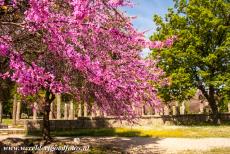
Archaeological Site of Olympia: Springtime in Ancient Olympia, Judas trees are in full bloom, the pink-purple flowers bloom vibrantly above the weathered stones of the ancient ruins. Ancient Olympia was abondoned in the 7th century, the first major archaeological excavations started in 1875. Ancient Olympia lies within walking distance of the modern town of Olympia. It is situated at the west end of the Peloponnese Peninsula in Greece. The Archaeological Site of Olympia was inscribed on the UNESCO World Heritage List in 1989.
